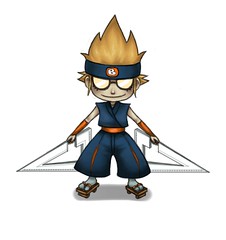I'll start off with how I feel about this test tomorrow: Not that great. I thought I understood everything before I entered that classroom today but the pretest was... confusing, and the cards! OH MY GAWSH, the cards... I'm not a big fan of them, but I will learn to love them.
Here are some wonderful pieces of useful information that should be useful:
1. A PERMUTATION is used when ORDER MATTERS. The lock on your locker is a permutation lock because the order the numbers are chosen effects whether the lock opens or not. For example the combo 17-4-56 is not the same as 56-17-4.
The formula you would use would be nPr - read as n pick r - where n is the number of objects to pick from and r is the number of objects that need to be arranged.
If you have non-distinguishable objects (like repeated letters in a word that you want to rearrange), then n!/k1!k2!k3!... where n is the number of letters in the word and k is the number of repeated objects.
2. A COMBINATION is different from a permutation. This is when order DOES NOT MATTER. Picking people for committees is an example of a combination because there are no places or ranks to order them in.
The formula you would use is nCr - which is read as n choose r - where n is the total number of objects and r is the number of objects you want to choose for you combo.
3. The FUNDAMENTAL PRINCIPLE OF COUNTING should have been first on my list but oh well... it's when you have p number of things and q number of things and u multiply them together, you'll get the number of possible combinations. Yay!
The ! means factorial. Factorial means that you multiply a nunber by every number below it until 1. So 5! would be 5x4x3x2x1.
4. CIRCULAR PERMUTATIONS are when you must rearrange things in a circle. The formula for this is (n-1)! because one object is the starting point and it does not count.
There are SPECIAL CASES like when the circle is a bracelet or a necklace because you can flip it over. For these cases the formula would be (n-1)!/2
5. For objects that MUST ALWAYS STICK TOGETHER (people wanting to sit together, certain books have to be side by side etc.), but those objects in a bag and count the bag as one object. Figure out the number of possible ways to arrange those objects. Then find the number of ways to arrange the objects inside the bag. Then multiply the two answers together to get the final answer... does that make any sense ? Well it does to me. :D
6. The BINOMIAL THEOREM can blow your mind away. It can find a specific term in a binomial expansion without actually expanding the whole binomial. Here is the formula:
 i is the term you want.
i is the term you want.n is the exponent
a is the first term and b is the second in (a+b)^n
WHEN LOOKING FOR THE MIDDLE TERM. IF THE NUMBER OF TERMS OF THE EXPANSION IS EVEN THERE IS NO MIDDLE TERM. REMEMBER THAT.
7. Pa-pa-pa-poker face, pa-pa poker face [8]. Cards. Yeah. Look at aldrin's and john's BOBs, they have that covered... I can't really explain it becuase i don't really know it.
I hope I have everything covered. If I don't please don't hesitate to tell me. Or if I have something wrong.. correct me ;D
I hope I don't fail tomorrow.
BREAK A PENCIL EVERYONE ;D


0 comments:
Post a Comment